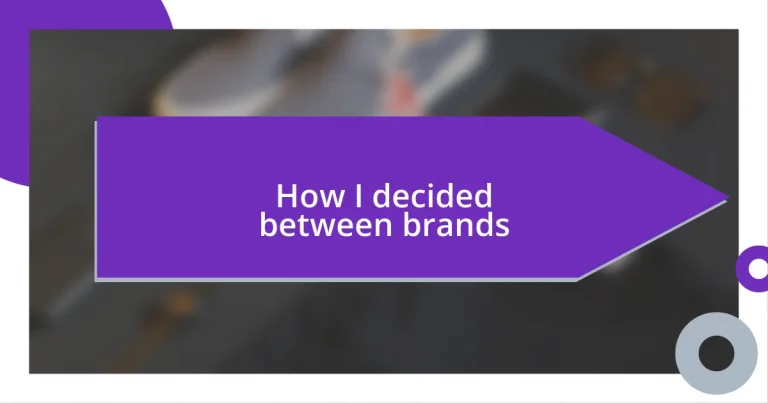Key takeaways:
- Understanding personal values and needs helps clarify brand choices, enhancing decision-making.
- Establishing clear evaluation criteria streamlines comparisons and connects choices to emotional insights.
- Analyzing customer feedback reveals real experiences that guide towards more informed, meaningful purchases.

Understanding brand options
When I think about understanding brand options, it often feels overwhelming. There are countless brands vying for my attention, and I can’t help but wonder: what really sets them apart? I remember scrolling through endless reviews, feeling a mix of excitement and confusion as I tried to differentiate between brands that seemed so similar yet promised vastly different experiences.
Diving deeper, I’ve realized that each brand carries a unique story or value proposition. For instance, when I was comparing athletic shoes, I found it fascinating how one brand emphasized sustainability, while another focused on cutting-edge technology. These distinctions made me reflect on my own values—did I want to prioritize the environment, or was performance my main concern? This discovery led me to define what truly mattered to me, making the choice clearer.
It’s also helpful to define your needs before exploring options. I once spent hours choosing a skincare line, unsure of whether I needed hydration or anti-aging solutions. Narrowing my focus not only eased my decision-making but also opened my eyes to how brands align with my specific needs. Have you ever found a brand that just “clicked” with your expectations? That feeling of alignment can significantly influence our choices.

Setting evaluation criteria
Establishing clear evaluation criteria is crucial when deciding between brands. Personally, I’ve learned that outlining what I’m looking for in a product can streamline the entire process. For example, while shopping for a laptop, I noted key attributes like battery life, performance, and price. This approach helped me to focus my search and ultimately make a choice that felt right for my needs.
I remember a time when I hesitated between two brands of coffee makers. I wanted one that was budget-friendly but didn’t sacrifice quality. By setting criteria such as brewing speed and ease of cleaning, I was able to compare the options side-by-side, leading me to a purchase I felt confident about. Have you ever experienced that moment of clarity where the best choice just reveals itself? It’s satisfying!
In the end, those criteria reflect not just practical needs, but also emotional connections to the brands. When I finally selected my coffee maker, it wasn’t just about functionality; the brand’s story resonated with my passion for sustainable living. That emotional insight made my decision all the more rewarding, proving that setting evaluation criteria goes beyond the basics and touches on personal values too.
| Criteria | Brand A | Brand B |
|---|---|---|
| Price | $100 | $120 |
| Battery Life | 10 hours | 8 hours |
| Warranty | 2 years | 1 year |

Gathering brand information
Gathering information about brands is a step that I always approach with curiosity. I like to dig into the brand’s history and ethos, as it often sheds light on what truly differentiates them. For instance, I remember researching a skincare brand that had an interesting journey from a small startup to a recognized name in the industry. Their commitment to natural ingredients and ethical sourcing resonated with my personal values, making my connection to the brand feel more authentic.
When I gather brand information, I usually keep a checklist handy to ensure I cover all important aspects:
- Brand history: Understanding the background helps me assess credibility.
- Product offerings: I look for a range of products that meet my needs.
- Customer reviews: These provide real-world insight into product performance.
- Sustainability practices: I value brands that prioritize the environment.
- Social media presence: Engaging content often reflects a brand’s community involvement.
By assembling these pieces, I can make a more informed decision, cultivating a sense of confidence in my choices.

Comparing product features
When I compare product features, I like to create a side-by-side comparison, kind of like a mini-report card. Recently, I found myself choosing between two similar smartphones—that exhilarating yet daunting experience! I noted down features like camera quality, storage options, and battery capacity. I can’t tell you how satisfying it was to watch my table fill up with data, as it really brought clarity to what would ultimately fit my lifestyle best.
One time, I was on the fence about two different running shoes. I started with the essential features: cushioning, weight, and durability. As I evaluated those attributes, I realized that while one pair was lighter, the other offered more support for my arches. Knowing that my feet gave me the freedom to run was a big deal to me! In that moment, I understood how those features reflect my personal needs, making the choice feel not just logical but deeply connected to my running journey.
Have you ever felt overwhelmed by the sheer number of features brands boast about? I certainly have. It’s easy to get lost in marketing jargon. That’s why I’ve learned to focus on what genuinely matters to me. For example, while those extra camera megapixels can be enticing, I often find that ease of use and reliable performance are ultimately what I cherish most. In the end, comparing product features is all about making choices that serve not just my needs, but my lifestyle.

Analyzing customer feedback
When I dive into customer feedback, I can’t help but feel a sense of excitement. It’s almost like peeling back layers to uncover hidden truths about the product. For example, I once scrutinized reviews on a popular coffee maker, and what struck me was how many users mentioned the same issues—leaking and inconsistent brewing temperatures. These consistent patterns in feedback made me reconsider whether the flashy marketing was worth my investment. Have you ever read reviews that resonate deeply? Those shared experiences often feel like conversations with fellow consumers, guiding my decisions.
I’ve even found value in less favorable reviews. One time, I was interested in a fitness tracker, but several comments pointed out that the app was buggy and slow. Instead of dismissing it, I took it seriously. This insight shaped my understanding of the product’s usability. If these customers struggled, I could only imagine how that might affect my motivation to use it consistently. It made me realize that I need technology that simplifies my life, not complicates it.
Analyzing customer feedback isn’t just about tallying up stars; it’s a deep dive into real-life experiences that inform my choices. I often look for patterns, focusing on recurring themes rather than just a single negative comment. For instance, when shopping for a winter jacket, I learned to pay attention to comments about warmth and comfort, especially during harsh winters. Those insights not only protect my wallet, but also help me choose products that truly match my needs. Isn’t it reassuring to know that others’ experiences can steer us in the right direction?

Considering price and value
When considering price and value, I often reflect on my past experiences with purchases that felt like great deals at first. Last year, I bought a budget vacuum cleaner, thinking I was being smart. It was affordable, but within weeks, it lost suction and left me frustrated with my decision. I learned then that sometimes spending a little more can actually save me money in the long run—something I now keep in mind every time I face a price tag.
For me, value isn’t just about the lowest price; it’s about the return on investment. I remember when I splurged on a high-quality kitchen knife. The initial cost was significant, but the precision, durability, and joy it brought to my cooking made it worth every penny. I still ask myself: will this item enhance my daily life? If the answer is yes, I find that my budget becomes a flexible guideline rather than a hard limit.
I constantly weigh price against experiences. Just the other day, I wrestled with the decision of whether to buy a premium hiking backpack. At first, the price made me hesitate. Yet, thinking back to a hike where I struggled with a flimsy pack, I felt an emotional tug towards durability and comfort for upcoming adventures. It’s moments like these that remind me: investing in quality often leads to richer experiences, making the price tag feel more like an assurance than a cost. Wouldn’t you agree that some purchases become cherished companions on our journeys?

Making the final decision
When it comes to making the final decision, I often find myself at a crossroads, weighing all the information I’ve gathered. A few months back, I was torn between two smartphone brands that I had been eyeing for weeks. After much deliberation, I realized that one had a feature set that matched my daily needs—like a superior camera that could capture those spontaneous moments with my kids. Isn’t it incredible how those small features can tip the scales?
I vividly remember making a last-minute decision at a store. I had my heart set on one brand, but the sales associate mentioned how satisfied customers were with another option’s longevity. That recommendation hit home for me because I had previously experienced the frustration of products that simply didn’t last. It made me question what I truly valued: immediate satisfaction or long-term reliability. I chose the latter, and that experience reinforced the importance of keeping an open mind even when I’ve made up my mind.
As I solidified my choice, I found myself reflecting on what truly resonated with me beyond the specs and pricing. I thought about how much I enjoyed supporting brands that align with my values, like those committed to sustainability. In the end, the decision felt right when I realized I was choosing more than just a product; I was endorsing a philosophy I believe in. Have you ever considered how the values behind a brand could enhance your satisfaction with a purchase? It sure makes the decision feel much more meaningful.














